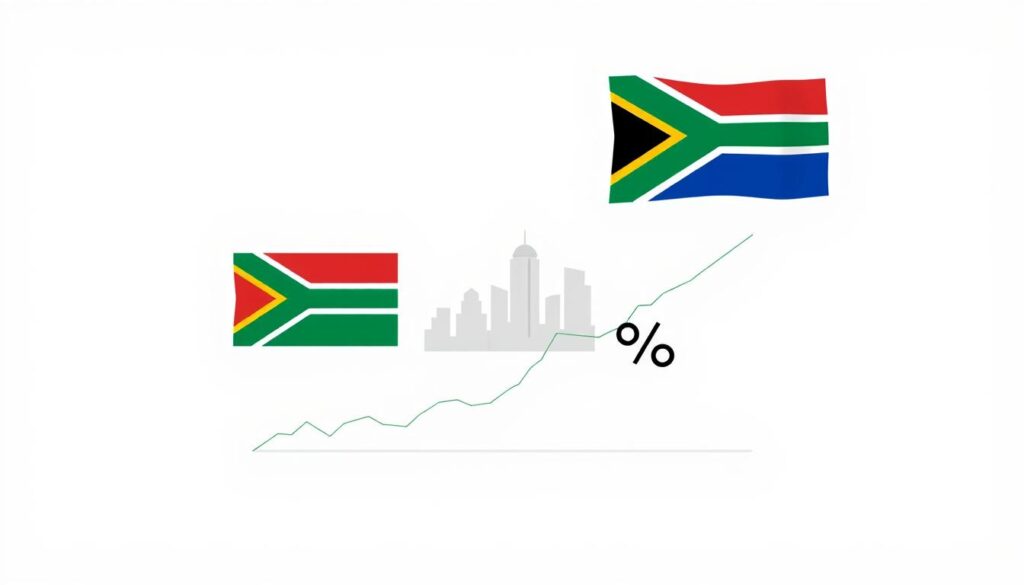Understanding South Africa’s interest rates is key for both homeowners and investors today. Interest rates shape our economy, affecting mortgages and investment chances. We’ll look at the current interest rates, historical trends, and what drives them. This helps people make smarter financial choices in a changing world.
Current State of South Africa’s Interest Rate
On July 31, 2025, the South Africa Reserve Bank announced a change in the country’s finance policy. They dropped the key interest rate by 25 basis points. This decision set the current interest rate at 7%, the lowest since November 2022.
Anúncios

Latest Interest Rate Announcement
The South Africa Reserve Bank responded to global economic worries and slower inflation predictions. The inflation measure, or CPI, shows a stable inflation rate of 3.0%. This led to rate cuts to help the economy grow.
Current Repo and Prime Lending Rates
The current repo rate is at 7.25%, and the prime lending rate is 10.75%. These rates changed after four rate cuts since mid-2024. These changes are essential for guiding how banks lend money and affect spending and saving in South Africa.
Historical Overview of Interest Rates in South Africa
In the last 20 years, South Africa’s interest rates have changed a lot. These changes show the economic ups and downs. They also show how the country has worked to keep its economy stable.
Trends Over the Past Two Decades
Between 1998 and 2025, interest rates in South Africa averaged 11.77%. These rates went up and down due to economic struggles. These included changes in inflation and recessions. The patterns show times of increasing and decreasing rates. This was to handle local and worldwide economic conditions.
Notable Highs and Lows
In June 1998, the interest rate hit a peak of 23.99% because of high inflation. But in July 2020, it dropped to a low of 3.50%. This was a response to the economic issues caused by the pandemic. These moments show the balance between fighting inflation and encouraging economic growth.
Factors Influencing Interest Rate Decisions
Various factors influence interest rates in South Africa. These include both domestic policies and the world scene. The way monetary policy is managed is key for keeping inflation in check. This helps shape the economy. The South African Reserve Bank uses these policies to help the economy grow by managing interest rates well.
Monetary Policy and Inflation Targeting
Inflation targeting has become a major plan for central banks. It aims to keep inflation low and steady. This method makes monetary policy more transparent. It lets policymakers show their goals clearly.
By having clear inflation goals, central banks can be more accountable. This guides economic activities and what consumers expect.
Global Economic Conditions
What happens in the world economy affects South Africa’s monetary policy. For example, changes in the US economy can affect markets worldwide. This includes South Africa.
Trade, investment flows, and global stability are very important. They influence how monetary policies are made. As the world economy changes, so do the factors that affect South Africa’s interest rates.
Impact of Interest Rates on Homeowners
Recently, interest rate cuts have made a big difference for South African homeowners. Families now find it easier to manage their finances, thanks to lower monthly bond repayments. These savings can be quite large, giving homeowners extra money for other important needs.
Monthly Savings from Recent Rate Cuts
Thanks to these rate cuts, homeowners are keeping more money in their pockets. They’re saving between R310 and R1,550 every month. This makes a big difference in family budgets, letting them use the extra money where it’s needed most.
Long-Term Financial Benefits
Looking ahead, these monthly savings add up to a lot over time. With lower payments, homeowners can use the money for future plans. This helps them build a stronger financial base for themselves and their families.
Understanding Inflation Trends in South Africa
In South Africa, keeping up with inflation trends is key for a stable economy. As the end of 2024 showed us, the inflation rate landed at 3.0%. This matches the Reserve Bank’s goal range of 3-6%. For next year, 2025, it might go up a bit to 3.3%. This is due to current economic conditions affecting prices and demand.
Current Inflation Rate and Projections
The inflation rate now sits within the target zone set by monetary authorities. Looking ahead to 2025, we might see a slight rise. This hints at possible changes in how people spend and save. It’s critical to keep an eye on these trends. They play a big role in shaping economic policies and interest rates.
Influence on Interest Rate Strategy
Inflation rates strongly influence South Africa’s approach to interest rates. The central bank tweaks rates to manage inflation and encourage economic growth. As inflation shifts, so do the strategies to keep the economy balanced. Expect future interest rates to adjust, affecting investments and borrowing across different areas.
Predicting Future Interest Rate Movements
In South Africa, knowing future interest rates is key for many people. Experts think interest rates might go down slowly, expecting the repo rate to be between 6.75% and 7.00% by end of 2025. This guess is based on several economic signs that shape rate trends.
Expert Forecasts for 2025 and Beyond
Economists and financial experts have made guesses about South Africa’s future interest rates. They see lower inflation and a steady global economy as main reasons for a drop in rates. They stress watching these economic signs closely to predict future rates.
Key Indicators to Watch
Watching specific economic signs closely helps foresee interest rate changes. Important signs include:
- The direction of South Africa’s inflation, highly impactful on monetary policy choices.
- The rand’s value against big currencies, affecting import costs and how much people spend.
- Changes in global economy, especially in trading and investing, that sway our economic health.
These factors are critical in figuring out where interest rates will go, important for smart financial choices in the future.
How Personal Factors Affect Your Interest Rate
Understanding how personal factors impact interest rates is key for those looking to borrow. Factors like your credit history and how big your deposit is play a big role. These determine the interest rates you can get. Banks look at these to see how much of a risk it is to lend to you. Having a good credit history shows you’re good with money. This can help you get better interest rates. On the other hand, the size of your deposit can also change your loan terms.
The Role of Credit History
Having a strong credit history is very important when you want to borrow money. Lenders check your credit to see if you’re good at paying back money. If your credit history is good, you might get lower interest rates. But, if your credit isn’t great, you might have to pay more. It’s a good idea to check and improve your credit score before you apply for loans.
Deposit Sizes and Their Impact
The amount of money you can put down as a deposit affects your interest rates too. A bigger deposit shows you’re serious and lowers the risk for the lender. This can mean lower interest rates for you. If you can put down a large deposit, you might get better rates and increase your chances of loan approval. So, it’s important to know how much you can afford to put down before you borrow.
Refinancing Options in a Lower Rate Environment
Right now, homeowners in South Africa are looking into refinancing. This is because of lower rates available. Knowing when to refinance can help you save more. If your loan’s interest rate is over 11.0%, it’s a good time to get a better deal. With a lower rate, you can save a lot on your monthly payments.
When to Consider Refinancing
There are a few signs that show it’s time to think about refinancing:
- You have a higher current interest rate on your home loan.
- Your credit score has improved since you initially took out the loan.
- You wish to change from a variable to a fixed rate loan for stability.
- Your income situation has changed, allowing for a more aggressive repayment plan.
Cost-Benefit Analysis of Refinancing
Before you decide to refinance, doing a cost analysis is key. The upfront costs of refinancing range between R15,000 to R30,000. It’s important to check if the monthly savings later will make up for these costs. Here’s what to think about:
- Calculate potential savings based on lower rates.
- Assess how long it will take to recoup refinancing costs through reduced monthly payments.
- Review any penalties associated with early repayment of your current home loan.
Opportunities Created by Lower Interest Rates
In South Africa, lower interest rates offer big benefits for home buyers and property investors. These conditions make it easier to save money and get more from investments. It’s key to know how to use these chances and build strong investment plans to win in today’s market.
For First-Time Home Buyers
Right now, lower interest rates give first-time buyers a great shot at joining the property market. They can borrow more easily and choose from more homes, even in nicer areas. This situation helps new buyers feel ready to take big steps for their future.
Investment Strategies for Property Investors
Property investors are also in a good spot thanks to lower interest rates. They can see bigger profits because it’s cheaper to borrow money. However, they need to think carefully about where to buy, what kind of property to choose, and current market trends. Even with good conditions now, being smart and doing homework is crucial to deal with market ups and downs.
Risks Associated with Low Interest Rates
Low interest rates can seem like a great deal because they make borrowing cheaper. However, they come with their own set of risks that should not be ignored. It’s also important to understand the difference between variable and fixed-rate loans. Moreover, global economic ups and downs can have a big impact, creating risks.
Variable vs Fixed Rate Loans
When choosing between variable and fixed-rate loans, there’s a lot to consider. Variable loans might have lower initial rates, making them seem appealing. But, there’s a catch: if interest rates go up, so do your monthly payments. Fixed loans, on the other hand, offer predictable payments but might cost more at the start. So, picking the right type of loan is key, especially in uncertain economic times.
Global Economic Uncertainty and Its Effects
The global economy can be unpredictable, affecting borrowers who enjoy low interest rates. Issues like trade tensions, rising prices, and political unrest can shake things up. These changes can cause interest rates to move in ways we might not expect. This can impact individuals and the economy alike. Being aware of these factors can guide borrowers through the challenges of low interest rates.
Conclusion
Interest rates in South Africa are very important for many people, like those borrowing money, investors, and those making policies. Right now, the low rates help especially homeowners and first-time buyers. This situation offers them good chances to get loans with nice terms, saving a lot of money later.
But, while there are advantages, it’s also key to watch out for risks and how the world’s economy might affect us. Things like inflation, how much our money is worth, and our trade with other countries can change what the South African Reserve Bank decides about interest rates.
As things keep changing, making smart money choices can really pay off. Watching how interest rates change and knowing your own money situation is crucial. It’s important for anyone trying to do well in South Africa’s financial scene right now.
FAQ
What is the current interest rate in South Africa?
How do interest rate cuts impact homeowners?
What is the long-term historical average interest rate in South Africa?
How does inflation affect interest rates?
What factors can cause interest rates to rise again?
How can personal financial factors impact the interest rates I receive?
What should homeowners consider when refinancing?
Are there risks associated with low interest rates?
How do lower interest rates benefit first-time home buyers?
What role do global economic conditions play in shaping South African interest rates?
Conteúdo criado com auxílio de Inteligência Artificial



